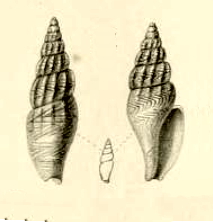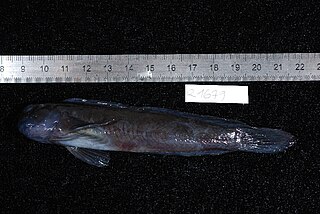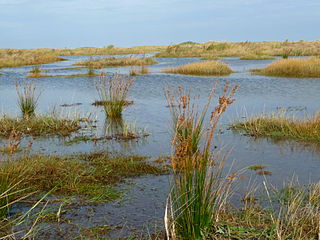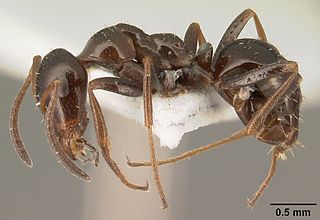
Juncaceae is a family of flowering plants, commonly known as the rush family. It consists of 8 genera and about 464 known species of slow-growing, rhizomatous, herbaceous monocotyledonous plants that may superficially resemble grasses and sedges. They often grow on infertile soils in a wide range of moisture conditions. The best-known and largest genus is Juncus. Most of the Juncus species grow exclusively in wetland habitats. A few rushes, such as Juncus bufonius are annuals, but most are perennials. Despite the apparent similarity, Juncaceae are not counted among the plants with the vernacular name bulrush.

Christian Ferdinand Friedrich Krauss, was a German scientist, traveler and collector.

Merwilla plumbea, also known as the blue squill, is a threatened bulb-forming perennial herb in the small genus Merwilla endemic to the Drakensberg.

Serruria, or spiderhead is a genus of flowering plants in the family Proteaceae, endemic to South Africa.

Juncus kraussii commonly known as salt marsh rush, sea rush, jointed rush, matting rush or dune slack rush, is of the monocot family Juncaceae and genus Juncus. It grows in salt marshes, estuarine and coastal areas.

Clionella kraussii is a species of sea snail, a marine gastropod mollusk in the family Clavatulidae.

Anachis kraussii is a species of sea snail in the family Columbellidae, the dove snails.

Motu Manawa-Pollen Island Marine Reserve is a 501 hectares (1.93 sq mi) protected area in the Waitemata Harbour in Auckland, New Zealand, established in 1996. It includes the entire area between Rosebank Peninsula and Waterview, and surrounds Motumānawa / Pollen Island and Traherne Island. Its northeastern boundary runs roughly parallel to Rosebank Peninsula, from the mouth of the Oakley Creek estuary. Its northernmost boundary is north of Pollen Island, at the same latitude as the tip of Point Chevalier. Its westernmost point is in the mouth of the Whau River, between the tip of Rosebank Peninsula and Te Atatū. It is bisected by the Northwestern Motorway.

Clanculus kraussii is a species of sea snail, a marine gastropod mollusk in the family Trochidae, the top snails.

Enchelyurus kraussii, Krauss' blenny, is a species of combtooth blenny found in coral reefs in the western Pacific and Indian Oceans. This species grows to a length of 4.5 centimetres (1.8 in) SL. The specific name honours the German scientist, traveller and collector Christian Ferdinand Friedrich Krauss (1812-1890).

Juncus maritimus, known as the sea rush, is a species of rush that grows on coastlines. It is sometimes considered conspecific with Juncus kraussii. It has a wide distribution across the western Palearctic realm.

Combretum kraussii, the forest bushwillow, is a medium-sized to large tree of eastern South Africa, Eswatini and southern Mozambique, which is found within, or in the vicinity of forests. The specific name commemorates Dr. F. Krauss who undertook a collecting trip to South Africa from 1838 to 1840.
Turbonilla kraussii is a species of sea snail, a marine gastropod mollusk in the family Pyramidellidae, the pyrams and their allies.

Combretastatin B-1 is a combretastatin and a dihydrostilbenoid. It can be found in Combretum caffrum, the Eastern Cape South African bushwillow tree or in Combretum kraussii, the forest bushwillow.
C. kraussii may refer to:

Bajcaridris is a genus of ants in the subfamily Formicinae. Its three species are known from northern Africa. B. theryi inhabits the meadows of the Atlas Mountains in Morocco, and B. kraussii and B. menozzii inhabit the wadis of the northern Sahara in Algeria.
Cloniocerini is a tribe of longhorn beetles of the subfamily Lamiinae. It was described by Lacordaire in 1872. It contains the single genus Cloniocerus, and the following species:
Cloniocerus hystrix is a species of beetle in the family Cerambycidae. It was described by Johan Christian Fabricius in 1781.
Spirobranchus kraussii, the blue coral-worm, is a species of marine invertebrate in the family Serpulidae of order Sabellida. It is native to the Indian Ocean.

Caquetaia kraussii is a species of fish endemic to the basin of the Atrato, Cauca, Magdalena, as well as the basin of Lake Maracaibo. The fish has been introduced to the Orinoco River basin. The specific name honours the German naturalist Christian F. F. Krauss (1812-1890) who was director of the Royal Natural History Cabinet in Stuttgart.














